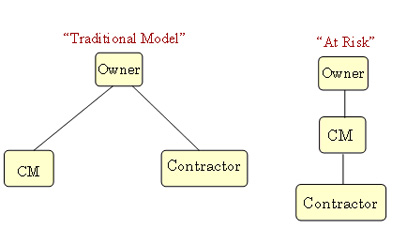The At-Risk Construction Manager: A "Twilight Zone" of Liability
Client Alert | 17 min read | 06.01.06
The at-risk construction manager (“CM”) project delivery method offers an attractive alternative to the traditional design-bid-build model. Under this model, the owner typically hires an additional party, the at-risk CM, to manage the entire construction process. The at-risk CM will usually participate in the initial stages of the project, including selection of design professionals, consulting on the project design, site selection and budgeting. This early involvement in the construction process promotes a comprehensive construction management approach that goes beyond the oversight role historically played by the traditional “agent” construction manager. The goal of the at-risk CM project delivery method is to use this enhanced management role to create a more cooperative and efficient construction process.
The expanding reliance on the CM project delivery method has led to a shift from the traditional “agent” CM, who contracts with the owner and acts as his agent, to the more aggressive “at-risk” CM. While the at-risk CM contracts with the owner to provide construction management and perhaps design consulting services, the at-risk CM also contracts directly with the contractors and/or suppliers in a role similar to that of a general contractor. This direct contractual relationship removes the CM from its historically sheltered role as the owner's agent, and places the CM in direct contractual privity with the contractors and suppliers, and thereby “at-risk.”

While the expanded power and influence of the at-risk CM is beneficial to achieving efficiencies in the construction process, it also significantly increases the at-risk CM's potential liability. The at-risk CM's liability can vary greatly depending on the terms of the contract with the owner regarding the scope of the CM's authority and responsibility, and also upon the terms of the CM's contract with the contractors and suppliers. For instance, the CM may have contractual responsibility for cost overruns incurred by the contractors due to delays and other impacts, without the right to pass such costs on to the owner. Of course, the rights and obligations of the at-risk CM depend upon the terms of the various contracts.
In addition to increased contractual liability, the CM's expanded role may also lead to greater common law liability. In general, the more involvement the CM has in the design and construction process, the greater the CM's liability. For example, in situations where the CM accepts increased responsibility, the CM may be liable to third parties for a variety of issues, including worker injuries, cost overruns and project delays.
The ever changing role of the CM is blurring the boundaries of the CM's liability into what one court recently referred to as a “twilight zone.” The broader and potentially uncertain liability of the at-risk CM is a major concern that should be carefully reviewed and assessed prior to contract execution. Contracts need to be carefully drafted to clarify the role of the CM at each phase of the design and construction process. These measures should help promote the efficient use of this promising project delivery method.
Legal and Industry Update:
REBUILDING CALIFORNIA'S INFRASTRUCTURE: The California Legislature recently passed a bill which would allow it to borrow over $37 billion dollars to improve California's infrastructure. If the bond measures are approved by voters in November's general election, the money will be used to finance affordable housing, highway and roadway systems, levee systems, and school modernization. Jordan Rau and Nancy Vogel, “Legislature OKs Biggest Bond Measure in Calif. History,” Los Angeles Times, May 5, 2006.
JOBSITE ACCIDENTS: While talking on his cell phone, a steel worker was injured by a falling plank from a scaffold. He brought an action for negligence against the general contractor and the subcontractor responsible for disassembling the scaffold. The jury found that the plaintiff's own carelessness caused the accident. The Court of Appeal noted that talking on a cell phone on a construction site is “tantamount to strolling on a battlefield wearing ‘horse blinders' and ear-plugs.” Held: substantial evidence supported the jury verdict. Jonkey v. Carignan Constr. Co., 42 Cal. Rptr. 3d 399 (Ct. App. 2006).
PUBLIC WORKS: Construction workers on a public works project brought a class action to recover prevailing wages against developers/contractors. The trial court sustained defendants' demurrers without leave to amend. The Court of Appeal affirmed, finding that plaintiffs only have a right of action against their direct employer, the subcontractor. Held: persons employed by a subcontractor on a public works project do not have a private right of action against the general contractor for failure to pay prevailing wages. Violante v. Communities Southwest Dev. and Constr. Co., 41 Cal. Rptr. 3d 673 (Ct. App. 2006).
BIDDING AND CRIMINAL PAST: The Department of Administrative Services requested proposals for asbestos, lead and mold removal services. AAIS Corporation's (“AAIS”) bid was excluded based on: (1) a current employee and former officer's guilty plea to mail fraud on a different project; and (2) suspicion that a former project had been obtained in an illegal manner. AAIS filed suit to enjoin the Department from excluding its bid, alleging favoritism. The trial court granted the Department's motion to dismiss, holding that AAIS lacked standing. The Appellate Court affirmed. Held: the exclusion of a bidder from consideration for a state contract because of the bidder's suspected prior criminal activities does not constitute favoritism that would give the bidder standing to pursue its claim. AAIS Corp. v. Dep't of Admin. Servs., 888 A.2d 1127 (Conn. App. Ct. 2006).
FALSE CLAIMS: Plaintiff Jimenez filed a False Claims Act action against the defendants. A year later, plaintiff received $125,000 in severance pay under a settlement agreement and release with defendants in which she stated that she had not initiated any such action. Held: a relator cannot accept severance pay, falsely represent in the release that no False Claims action was pending, and then pursue recovery under the False Claims Act, without at least returning the severance funds. United States ex. rel. Jimenez v. Health Net Inc., 2005 WL 2002345 (D. Colo. 2005).
C&M News:
- Randall L. Erickson was named a 2006 Southern California Super Lawyer by Los Angeles Magazine for his work in the construction industry. Mr. Erickson is currently focusing on expanding his ADR practice.
- Crowell & Moring acted as special counsel in TiVo Inc.'s recent successful patent infringement suit against EchoStar Communication Corp. A jury in the Eastern District of Texas found that EchoStar willfully infringed upon TiVo's multimedia time warping system patent, and awarded $74M.
- Mr. Erickson, Steven Rice, Deborah Arbabi, Theresa Lopez, and Van Nguyen recently negotiated a settlement in a long standing construction case involving complex defect, contract and tort claims. The case involved an infrastructure project, which included, among other things, improvements to a flood control channel adjacent to a residential development. At the time the case settled, there were more than a dozen parties in the case.
- In December 2005, Stuart Einbinder was on a panel presentation at the Construction Superconference entitled, “The Construction Manager at Risk by Contract and Conduct.”
- The Legal Advisory Committee of the Association of General Contractors of California met on May 10, 2006 at Crowell & Moring's Irvine office. Mr. Erickson spoke to the group on the current state of the law in California regarding architects' and engineers' liability to general contractors for economic damages.
- On May 11th and 12th, Crowell & Moring held its annual Western Ounce of Prevention Seminar (“WOOPS”), “Procurement in Times of Turmoil and Intense Review.” Michael Newman, Donald Sovie, Brian Russ, and Glenn Rowley spoke on topics including Qui Tam/False Claims Act Developments, Risks for the Foreign Buyer and U.S. Seller, Suspension and Debarment and Compliance, Due Diligence Issues, Contingency Contracting, and Lobbying Reform.
- On May 24, 2006, Mr. Erickson spoke to a group of owners and professionals in the construction industry at a Lorman Education Services Seminar entitled “Construction Change Orders and Claims.”
- On June 1, 2006, Crowell & Moring, in affiliation with the California Council for International Trade, hosted a conference on understanding the impact of globalization on international companies doing business in California, entitled, “Globalization Accelerates: Trade and Business Strategies for the Pacific Rim.” Seminar topics included leveraging trade policy for business success in the Pacific Rim, expanding in the U.S. market, and challenges for multinationals with U.S. business.
Insights
Client Alert | 4 min read | 04.24.24
Muldrow Case Recalibrates Title VII “Significant Harm” Standard
On April 17, 2023, the Supreme Court handed down a unanimous decision in Muldrow v. City of St. Louis, Missouri, No. 22-193, holding that transferees alleging discrimination under Title VII of the Civil Rights Act of 1964 need only show that a transfer caused harm with respect to an identifiable term or condition of employment. The Court’s decision upends decades of lower court precedent applying a “significant harm” standard to Title VII discrimination cases. As a result, plaintiffs claiming discrimination under Title VII will likely more easily advance beyond motions to dismiss or motions for summary judgment. In the wake of the Court’s decisions in Students for Fair Admissions, Inc. v. President and Fellows of Harvard College (6-2), No. 20-1199, and Students for Fair Admissions, Inc. v. Univ. of North Carolina (6-3), No. 21-707 (June 29, 2023), Muldrow will also likely continue to reshape how employers conceive of, implement, and communicate workplace Diversity, Equity and Inclusion (“DEI”) efforts. The decision may be used by future plaintiffs in “reverse” discrimination actions to challenge DEI or affinity programs that provide non-economic benefits to some – but not all – employees. For example, DEI programs focused on mentoring or access to leadership open only to members of a certain protected class could be challenged under Muldrow by an employee positing that exclusion from such programs clears this new, lower standard of harm.
Client Alert | 3 min read | 04.23.24
DOJ Promises NPAs to Certain Individuals Through New Voluntary Self-Disclosure Pilot Program
Client Alert | 3 min read | 04.23.24
Client Alert | 5 min read | 04.23.24


